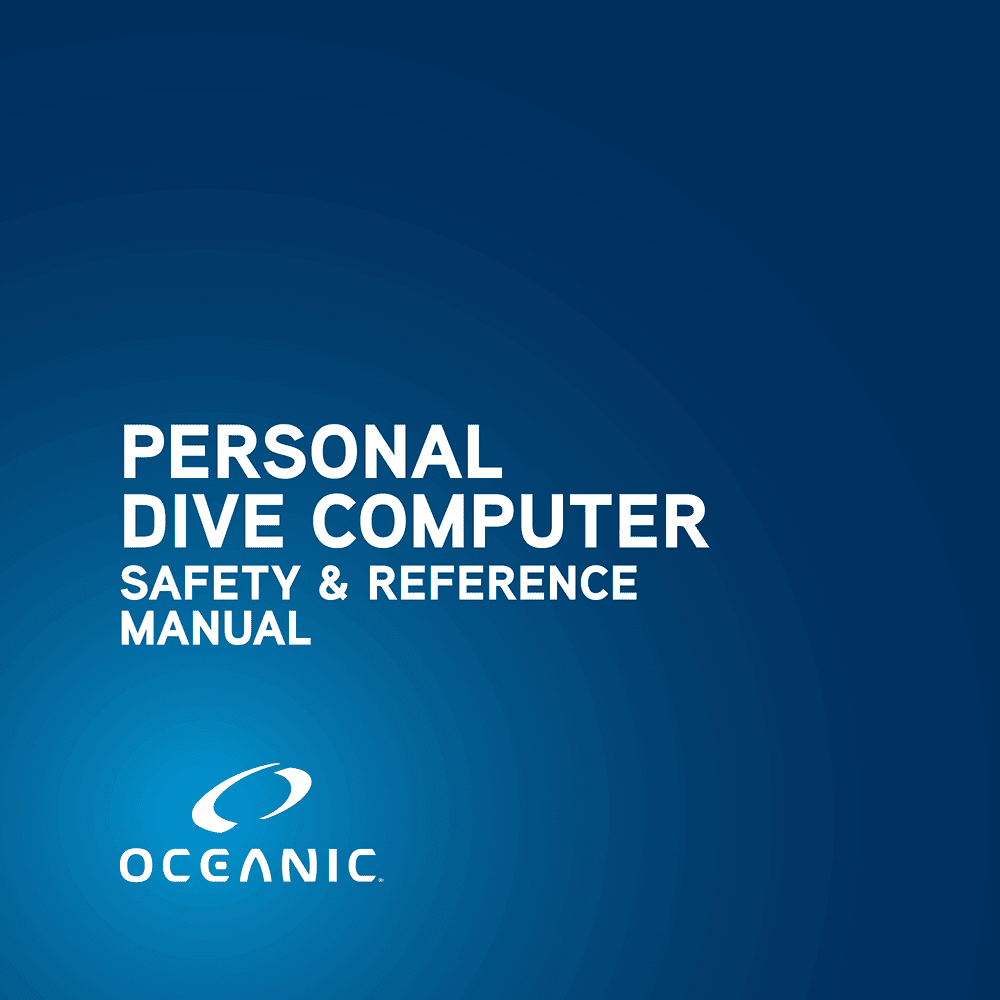Oceanic Personal Dive Computer Safety and Reference Manual
Download PDF Oceanic Personal Dive Computer Safety and Reference Manual (EN) 40 pages Doc.No. 12-2262-r12 (10/13/14), 12-2262-r24 (1/25/23) zip
Description
This PDF safety and reference manual is for the Oceanic Personal Dive Computers.
About the Item
Oceanic Personal Dive Computer Safety and Reference Manual
The intent of this manual is to consolidate information that is common to the various models of Oceanic PDCs (PDC = Personal Dive Computer).
It is imperative that you read and understand this manual, as well as the OPERATING MANUAL for your specific model PDC prior to diving with it.
NOTE: In the event that information provided in the OPERATING MANUAL varies from information provided in this Safety and Reference Manual, the OPERATING MANUAL shall be the overriding document to refer to.
DOCUMENT(S) AVAILABLE
(PDF) SAFETY AND REFERENCE MANUAL
Available Languages
ENGLISH (EN)
SUMMARY OF CONTENTS
– Responsible Computer Diving
– The Code Of The Responsible Diver
– Responsible Diving Begins With ..
COPYRIGHT NOTICE
SYMBOLS
Symbols that are used in this manual and the PDC operating manuals to bring your attention to information having various degrees of importance.
INTRODUCTION
Oceanic PDCs have a wide array of features and functions that are described in detail in the Operating Manual for the specific model that you have.
It is extremely important that you read the Operating Manual and understand it completely before attempting to use your new Oceanic PDC.
Remember that technology is no substitute for common sense, and a PDC only provides the person using it with data, not the knowledge to use it. Remember also that the PDC does not actually measure and test the composition of your body tissue and blood.
WARNINGS and SAFETY RECOMMENDATIONS Relating to INTENDED USE
DIVE COMPUTER PERFORMANCE
DUAL ALGORITHM
Most current Oceanic PDCs feature both the Pelagic Z+ and the DSAT algorithms, which allows you to choose which set of NDLs (No Deco Limits) will be used for Ni/O2 calculations and displays relating to Plan and DTR (Dive Time Remaining).
WARNINGS and SAFETY RECOMMENDATIONS relating to ALTITUDE
ALTITUDE DIVING
Atmospheric pressure decreases as Altitude increases above sea level. Weather systems and ambient temperature also affect barometric pressures. Consequently, Depth reading instruments that do not compensate for the decrease in ambient pressure indicate Depth readings shallower than the Depth they are actually at.
DECOMPRESSION MODEL
The decompression models used are based on no decompression multi level repetitive dive schedules successfully tested and validated.
Using an Oceanic PDC, just as using the U.S. Navy (or other) Decompression Tables, is no guarantee of avoiding decompression sickness.
WARNINGS and SAFETY RECOMMENDATIONS relating to OPERATION
TISSUE LOADING BAR GRAPH (TLBG)
The TLBG offers you a convenient way to consistently monitor how close you are coming to the No Decompression Limit.
MULTIPLE TISSUE TRACKING
An Oceanic PDC tracks 12 tissue compartments with halftimes ranging from 5 to 480 minutes. The TLBG displays the controlling compartment, the one important at that time.
NO DECOMPRESSION LIMITS
Refer to the tables in the Operating Manual provided with your specific PDC for No Decompression Limits for various altitudes.
WARNINGS and SAFETY RECOMMENDATIONS relating to DIVE PLANNING
OXYGEN EXPOSURE LIMITS
Predicted exposure limits and oxygen calculations associated with the PDCs’ Nitrox modes are based on maximum exposure durations published by the NOAA (National Oceanic and Atmospheric Administration) in the NOAA Diving Manual.
DIVE TIME REMAINING (DTR)
One of the most important features of Oceanic PDCs is the DTR numeric display.
– No Deco Dive Time Remaining (NDC). NDC is the maximum amount of time that you can stay at your present depth before entering decompression.
– O2 Time Remaining (OTR). Oxygen accumulation (exposure) during a dive, or 24 hour period, appears graphically as the O2 Bar Graph (O2BG) or numerically as %O2.
– Air Time Remaining (ATR). ATR is the time you can remain at your present depth and still surface with the tank pressure reserve (End Gas Alarm Set Point) that you set prior to the dive.
WARNINGS and SAFETY RECOMMENDATIONS relating to OXYGEN
ASCENDING TO THE SURFACE
While ascending to shallower depths, the segments that have filled up the TLBG will begin to recede, offering a graphic representation of your multilevel diving capability.
– No Deco Deep Stop. Most all current Oceanic PDCs are configured with a Deep Stop feature that can be set On or Off prior to your dives.
– No Deco Safety Stop. If you have not entered Deco, a Safety Stop made between 10 and 20 FT (3 and 6 M) is strongly recommended as a standard procedure before completing your ascent.
– Fixed or set Stop Depth/Time. Upon ascent to within 5 FT (1.5 M) deeper than the Stop Depth, on a No Deco dive in which Depth exceeded 30 FT (9 M), Stop at the Depth set will be displayed with Stop Time counting down to 0:00 (min:sec).
– Timer use set On. Upon ascending to 20 FT (6 M) on a No Deco dive in which Depth exceeded 30 FT (9 M), a Run Timer will appear displaying 0:00 (min:sec) until started.
– VARI (Variable Ascent Rate Indicator). Most all Oceanic PDCs are configured with a VARI (bar graph) that shows how fast you are ascending. When you exceed the maximum ascent rate allowed for the depth you are at, the VARI will enter the Alarm (Too Fast) zone and you will be alerted by all segments flashing which will stop when your ascent rate is slowed.
DECOMPRESSION
Oceanic PDCs are sophisticated instruments designed with capabilities that go beyond the range of recreational diving with compressed air.
– Managing Decompression Stops. You should stay slightly deeper than the required Deco Stop Depth indicated until the next shallower Stop Depth appears.
VIOLATION MODES
When you exceed certain limits, Oceanic PDCs alert you with visual and/or audible warnings and operate in special Violation modes.
– Conditional Violation Mode (CV). CV is entered during Deco if you ascend shallower than the Required Deco Stop Depth displayed.
– Delayed Violation # 1 – above a required Deco Stop Depth for more than 5 minutes.
– Delayed Violation # 2 – Deco Stop between 60 FT (18 M) and 70 FT (21 M) is required.
– Delayed Violation # 3 – exceeding Max Operating Depth (MOD).
– Violation Gauge Mode (VGM). Five minutes after reaching the surface from a dive in which a Delayed Violation occurred, operation will enter VGM.
UNEXPECTED LOSS OF DISPLAY
If your PDC stops working for any reason, it is important that you have anticipated this possibility and are prepared for it. If not, wait 24 hours prior to using another PDC.
FLYING AFTER DIVING
In 1990 the Undersea and Hyperbaric Medical Society (UHMS) published a set of guidelines aimed at minimizing the possibility of decompression sickness due to flying too soon after diving.
TISSUE DESATURATION
Time to Desaturate (Desat Time) is a display of calculated time for tissue desaturation of nitrogen at sea level taking into consideration the Conservation Factor setting.
MAINTENANCE AND SERVICE
A PDC must be protected from shock, excessive thermal conditions, chemical attack, and tampering.
OPERATING TEMPERATURE
CLEANING
ANNUAL INSPECTIONS
Your PDC should be inspected annually by an Authorized Oceanic Dealer who will perform a factory prescribed function check and inspection for damage or wear.
HOW TO OBTAIN SERVICE
WARNINGS and SAFETY RECOMMENDATIONS relating to EXTREMES
WARNINGS and SAFETY RECOMMENDATIONS relating to DECOMPRESSION
WARNINGS and SAFETY RECOMMENDATIONS relating to VIOLATIONS
WARNINGS and SAFETY RECOMMENDATIONS relating to FLYING AFTER DIVING
WARNINGS and SAFETY RECOMMENDATIONS relating to MAINTENANCE and SERVICE
GLOSSARY
EUROPEAN UNION PERSONAL PROTECTIVE EQUIPMENT DIRECTIVES
UKCA (U.K. CONFORMITY ASSESSED) PERSONAL PROTECTIVE EQUIPMENT DIRECTIVES
RISK ASSESSMENT
FCC
Why download the Manual?
This safety and reference manual provides all the information about Oceanic personal dive computers, as detailed in the table of contents. Reading it completely will address most questions you might have. You can download and save it for offline use, including viewing it on your device or printing it for your convenience if you prefer a paper version.
How to download the Manual?
Download it by clicking the button below
Helped you out?
Glad to hear that. It would be awesome if you could . . .


